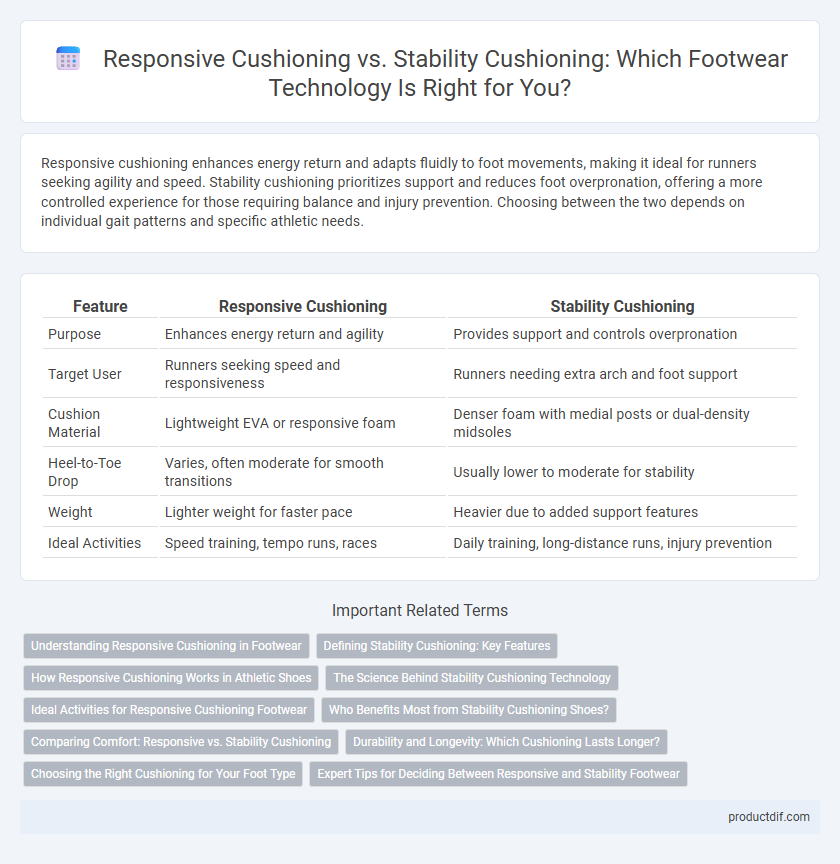Responsive cushioning enhances energy return and adapts fluidly to foot movements, making it ideal for runners seeking agility and speed. Stability cushioning prioritizes support and reduces foot overpronation, offering a more controlled experience for those requiring balance and injury prevention. Choosing between the two depends on individual gait patterns and specific athletic needs.
Table of Comparison
| Feature | Responsive Cushioning | Stability Cushioning |
|---|---|---|
| Purpose | Enhances energy return and agility | Provides support and controls overpronation |
| Target User | Runners seeking speed and responsiveness | Runners needing extra arch and foot support |
| Cushion Material | Lightweight EVA or responsive foam | Denser foam with medial posts or dual-density midsoles |
| Heel-to-Toe Drop | Varies, often moderate for smooth transitions | Usually lower to moderate for stability |
| Weight | Lighter weight for faster pace | Heavier due to added support features |
| Ideal Activities | Speed training, tempo runs, races | Daily training, long-distance runs, injury prevention |
Understanding Responsive Cushioning in Footwear
Responsive cushioning in footwear enhances energy return and impact absorption, providing a dynamic and comfortable experience during activities like running or training. This technology uses advanced foams or gels that adapt quickly to foot strikes, promoting natural movement and reducing fatigue. Understanding responsive cushioning helps athletes and casual wearers select shoes that balance comfort with performance demands.
Defining Stability Cushioning: Key Features
Stability cushioning in footwear provides enhanced support by incorporating medial posts or dual-density midsoles that prevent excessive inward foot roll (overpronation). Key features include firmer foam zones on the inner side of the midsole to maintain alignment and improve balance during movement. This type of cushioning is ideal for runners or walkers seeking to reduce injury risk linked to improper foot mechanics.
How Responsive Cushioning Works in Athletic Shoes
Responsive cushioning in athletic shoes utilizes advanced foam compounds and air pockets that quickly compress and rebound with each stride, enhancing energy return and propulsion. This technology adapts to varying impact forces, providing dynamic shock absorption that supports faster movements and improved agility. Designed for athletes who require speed and responsiveness, it enables a more efficient gait cycle and reduces fatigue during performance.
The Science Behind Stability Cushioning Technology
Stability cushioning technology in footwear employs medial posts or dual-density foams strategically placed to prevent excessive inward foot roll, known as overpronation. This biomechanical approach enhances support by stabilizing the foot during the gait cycle, reducing strain on muscles and joints. Research shows that stability cushioning improves alignment and decreases injury risk for runners with flat arches or low arch support needs.
Ideal Activities for Responsive Cushioning Footwear
Responsive cushioning footwear is ideal for high-impact activities such as running, jumping, and sprinting, where quick energy return and shock absorption are essential for performance and injury prevention. These shoes enhance agility and speed by providing a springy, flexible feel, making them perfect for sports like basketball, tennis, and cross-training workouts. Lightweight construction combined with responsive midsoles supports explosive movements and rapid transitions on various surfaces.
Who Benefits Most from Stability Cushioning Shoes?
Stability cushioning shoes are designed primarily for individuals with moderate overpronation who require extra support to prevent excessive foot rolling. Runners and walkers with flat feet or low arches benefit most from these shoes, as they help maintain proper alignment and reduce the risk of injury. Athletes seeking enhanced medial support for prolonged training sessions also find stability cushioning essential for improved comfort and performance.
Comparing Comfort: Responsive vs. Stability Cushioning
Responsive cushioning delivers a dynamic and springy feel by quickly adapting to foot strikes, ideal for runners seeking energy return and lightweight comfort. Stability cushioning offers enhanced support and medial control, reducing overpronation and providing a more secure, balanced ride for those needing orthopedic assistance. Choosing between them hinges on individual gait patterns and comfort preferences, with responsive cushioning favoring agility and stability cushioning prioritizing arch support and injury prevention.
Durability and Longevity: Which Cushioning Lasts Longer?
Responsive cushioning typically features materials like EVA foam or TPU that offer quick energy return but may compress faster, affecting durability over time. Stability cushioning incorporates denser foams and supportive elements such as medial posts, enhancing structural integrity and prolonging lifespan under regular wear. Shoes with stability cushioning generally exhibit superior longevity due to their reinforced construction designed to maintain support and cushioning properties longer.
Choosing the Right Cushioning for Your Foot Type
Responsive cushioning adapts dynamically to your foot's movements, providing energy return and support ideal for neutral or underpronators. Stability cushioning enhances medial support and reduces overpronation, making it the best choice for runners with flat feet or low arches. Selecting the right cushioning involves assessing your foot type and gait pattern to optimize comfort, prevent injury, and improve overall performance.
Expert Tips for Deciding Between Responsive and Stability Footwear
Expert tips for choosing between responsive and stability footwear center on your gait pattern and foot pronation. Runners with a neutral or supinated gait benefit from responsive cushioning that offers energy return and flexibility, enhancing overall performance. Those with overpronation require stability cushioning to provide extra support, control motion, and reduce injury risk during high-impact activities.
Responsive Cushioning vs Stability Cushioning Infographic

 productdif.com
productdif.com